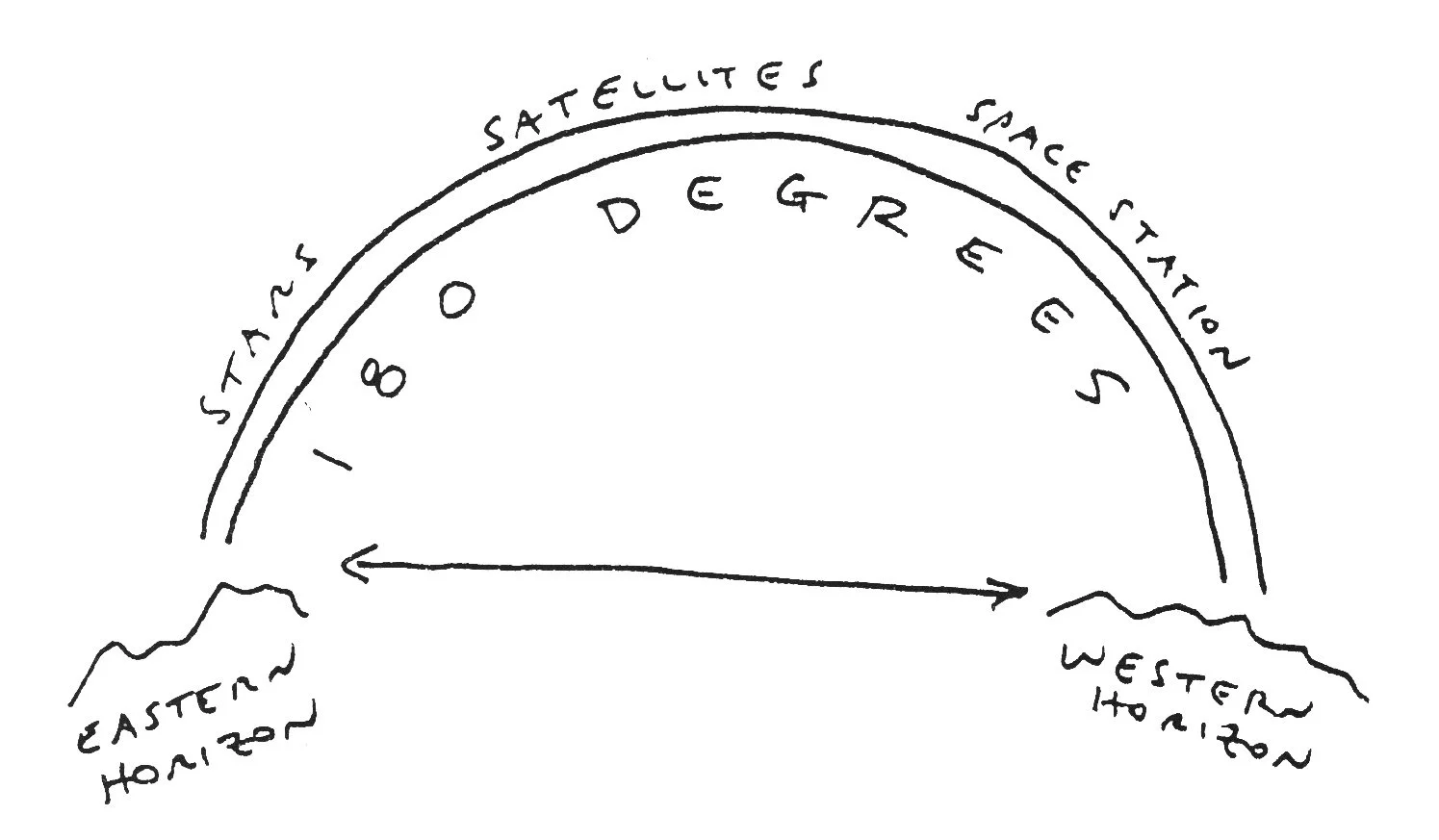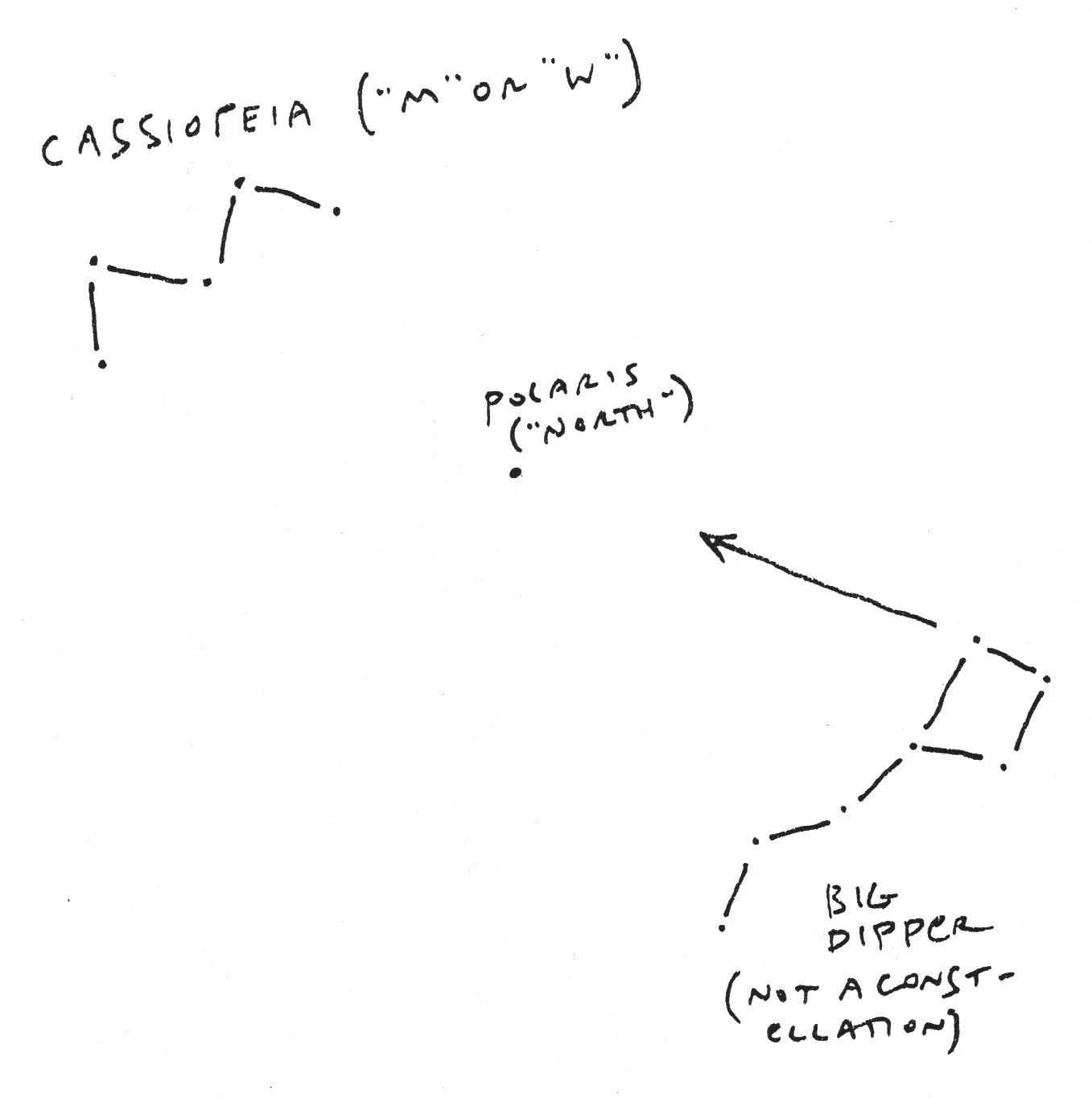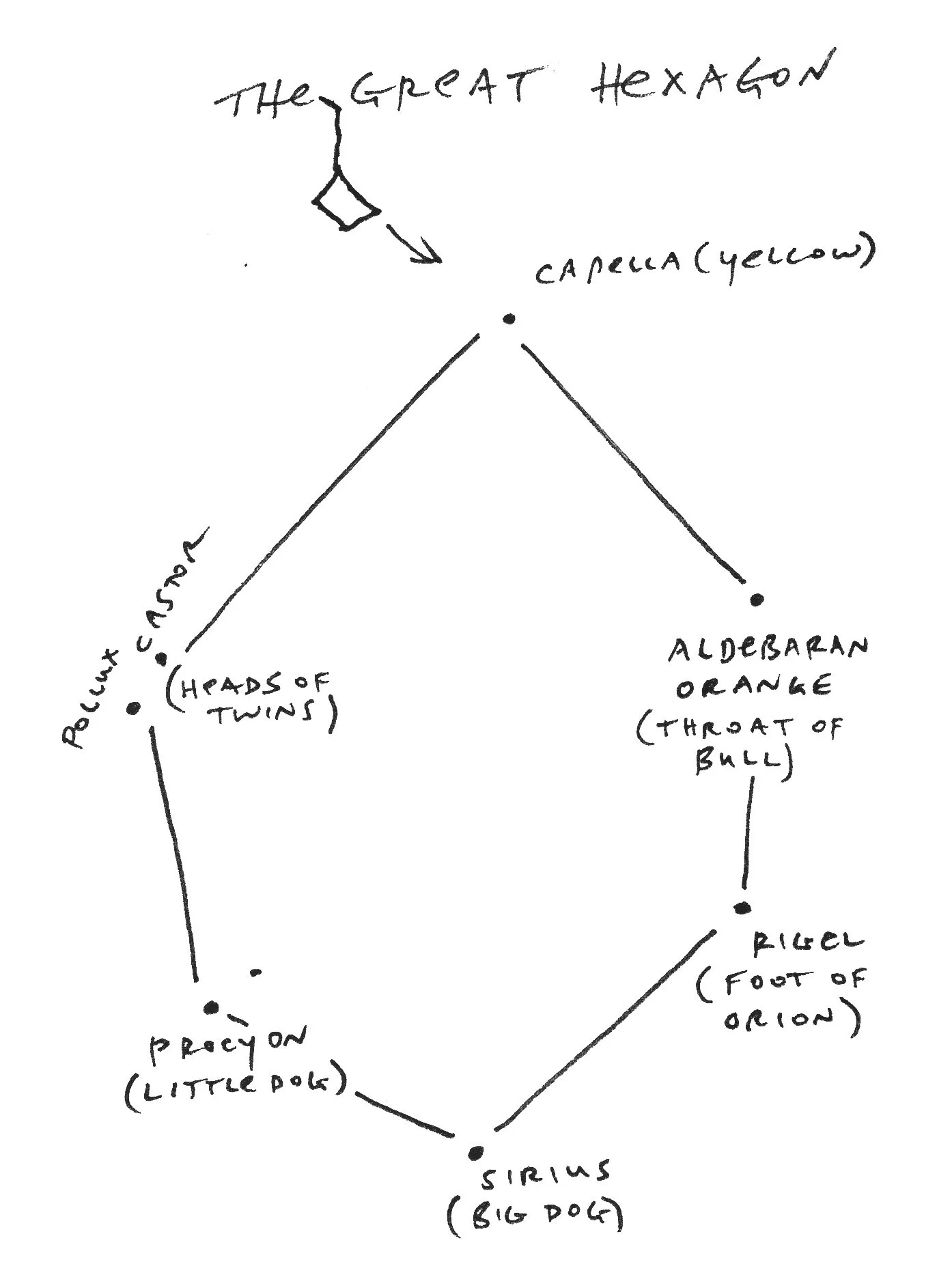By Jack Forinash
A special edition of the stargazing guide, with a special print-at-home zine, created expressly for The Great Northern.

ASTRONOMY: The science of the heavens.
ASTROLOGY: The story of the heavens.
This night sky guide is prepared for those attending the 2024 Great Northern Festival, in St. Paul, Minneapolis, and surrounding areas, at about 45 degrees north latitude, or, in other words, halfway between our globe’s equator and the North Pole. This guide is an introduction to night sky viewing; anyone of any age and any stargazing experience should be able to go outside and orient themselves to our place in the universe, specific to this year, this winter season, and this setting in the Great North.
First up, a stellar Lookbook! I made you this zine that you can print onto regular paper, fold up, and take with you. The Lookbook exhibits a few of the top constellations and asterisms that you should be able to locate on a clear, dark night during the Festival.
Grab your own Lookbook by downloading this PDF, printing on regular letter-size paper, and folding it. Now it fits in the pocket of your winter coat!
No artistic skills required! If you haven’t ever made a zine before, here is a link to beautiful and simple-to-follow instructions from my friend Shay. Or for visual learners, watch a video here on how to fold and cut the paper to make it into a little book!
PUBLIC SERVICE ANNOUNCEMENT
Before we get into it, some tips and requests for having the best experience. Please:
-
Bundle up. It’s cold out there! To really get in some time with the stars, you’re gonna need at least 30 minutes of time outside.
-
Check the weather: look for a clear night as clouds are going to impede being able to “connect the dots.”
-
Leave behind your phone! Phones are both too bright and the “star apps” don’t really work to teach you how to recognize and learn constellations.
-
Do your part in your community to limit LED lights. LEDs are 1/30th the brightness of the Sun and are as bright a mile away as they are a foot away. Shield LED-powered lights down and out of direct line of sight at your home and in your community. Because they disrupt your vision, don’t use or look at LEDs (including your phone) for 15 minutes before going outside so your eyes can naturally adjust and pupils dilate to be able to see more stars.
-
If light is needed, use red lights only. Red filters on lights don’t hurt our human eyes as much.
-
Go out again tomorrow, and the next day. Repetition is the only way to gain competency.
First up, let’s talk about la Luna:
At the exact moment the sun sets in the west on January 25th, look to the east to see the Full Moonrise with 100% illumination. The brightness of the Sun’s reflection makes this first night perfect for outdoor adventuring without any need for flashlights. It also means that these first couple days of The Great Northern Festival are not great for stargazing. However, each day thereafter the 25th, the Moon rises 50 minutes later night after night, waning a bit each day, becoming a Last Quarter Moon (50% illuminated) by February 3rd. For the best stargazing during the Festival, go outside an hour or so after sunset from January 29th through the end of the Festival.
Next, the stars above:
Under the best clear conditions, the human eye can only see about 2,000 stars. And really only ~850 are classified in the highest five magnitudes of apparent brightness. (Hopefully this helps to scale things so you can be less overwhelmed.)
Of the 21 brightest stars, seven are only visible from the Southern Hemisphere, leaving 14 for us to see here in the Northern Hemisphere at some point in a year.
There are only 88 constellations total. About 26 are out in a given night in the Northern Hemisphere. Many are quite small, dim, and/or “modern.”

The whole sky — all the way around Earth — is 360 degrees. At any point while standing on Earth, the most we could see (without trees, mountains, buildings, light pollution, etc.) is 180 degrees, from horizon to horizon.

An outstretched fist equates to about 10 degrees of the sky, while a finger is 1 degree. So when you hear something say, “Star X is 22 degrees east from Star Y,” extend your arm fully in a closed fist and close one eye, then place the edge of your thumb at Star X, then move the distance of your fist east to make 20, then extend out two fingers and add that to the spacing to reach 22 degrees. It works for all bodies due to our innate human-cosmic proportions! As the stars appear static to us (at least during a human lifetime), these “distances” between them are always the same. The way to learn constellations is to learn who is neighbors to whom, via repetition night over night.

Our current pole star (“north star”) is Polaris. It’s not that bright but it is north…for now. As the Earth slightly and slowly wobbles, taking ~26,000 years to complete a full wobble, our “north star” switches. Vega, the bright blue one in summertime, will be north in ~13,000 years, and was north 13,000 years ago at the end of the last glacial period.

The “Big Dipper” is usually a good place to start, if you can see it near the northeast horizon. In the winter, Cassiopeia is helpful, sitting within the ribbon of the Milky Way, always “catching” the north star Polaris. The seven stars of the so-called Big Dipper are part of a larger constellation “The Great Bear” (Ursa Major). The stars at the cup “pour out” toward Polaris, always. Cassiopeia (five stars in a “W” or “M” shape) are always opposite the Big Dipper. Our night sky rotates around the north star every day (or every 23 hours and 56 minutes).

Visible in wintertime is “The Great Hexagon,” an asterism of six of the 21 brightest stars in the night sky. Locate Capella—a bright yellow star nearly directly above you—by drawing a line out from the top two stars of the Big Dipper’s cup. From there, track nearly equidistant between the other points of orange Aldebaran, blue-white Rigel, bright blue Sirius, yellow Procyon, yellowish Pollux with his twin Castor, then back to Capella to complete the hexagon.
ICYMI: Download and print your own Winter Hexagon Lookbook here!
Star light, star bright, the first star I see tonight…is probably a planet!
Planet means “wanderer,” so unlike the “fixed” stars that appear in the same position year over year, the planets move around from one area of the night sky to another. The planets, after all, are much, much closer than the stars. Planets emit no light of their own. Like the Moon, they reflect the Sun’s light. The bright planets you can expect to see in the night sky in late January and early February of 2024 are Jupiter, Saturn, and Venus:
King Jupiter is probably what you’re looking at! It’s super big so it reflects a lot of the Sun’s white light, visible even with the Full Moon and the Waning Moons thereafter during the Festival. Uranus is near Jupiter just to the east in the night sky, but likely unable to be seen without binoculars. Similarly, Neptune is up there cruising around, but invisible without a fancy telescope.
Ringed Saturn, also quite bright, is to the southwest just after sunset near the horizon, eventually dropping below the horizon by mid-February.
“Morning Star” Venus—the brightest object in the night sky behind the Moon—will rise just before the Sun at the southeast horizon through January and most of February, near Antares (“not Mars”), the noticeable red star that is part of the Scorpion constellation. Mercury is there too hanging out with Venus, but much less bright, and becoming invisible in February due to its proximity to the Sun being the first planet. Mars, like Mercury, is blotted out by the glare of the Sun right now.
And as for Pluto, I still count him. But without a very expensive telescope, he’s always invisible from Earth.
“What’s your sign?”
The ramble twins crab liverish, scaly scorpions are good water fish.
The constellation of your Sun Sign—the sign most will say when asked “what’s your sign?”—is not visible at night on/near your birthday. This is because the Sun is passing through that sign around that time of year.

Now, there’s some small discrepancies because the 12 signs (constellations) of the zodiac aren’t perfectly spaced on a 360-degree circle—and because the zodiac was (probably) first developed by the Sumerians and adopted by the Babylonians 3,600-6,600 years ago (see the section above on the “north” star and the Moon-caused “wobble”).
The zodiac (“circle of animals”) is a nighttime annual clock, starting at zero on the spring equinox (~March 20) with Aries.
-
Aries (Ram), fire sign: associated with the head. Mar 21–Apr 19. Confident, honest, impatient.
-
Taurus (Bull), earth sign: associated with the throat/neck. Apr 20–May 20. Stubborn, stable, devoted.
-
Gemini (Twins), air sign: associated with the arms. May 21–Jun 20. Curious, inconsistent, adaptable.
-
Cancer (Crab), water sign: associated with the stomach. Jun 21–Jul 22. Emotional, loyal, sympathetic.
-
Leo (Lion), fire sign: associated with the heart. Jul 23–Aug 22. Principled, powerful, generous.
-
Virgo (Virgin), earth sign: associated with the digestive system. Aug 23–Sep 22. Analytical, self-/critical, all work.
-
Libra (Scales), air sign: associated with the kidneys. Sep 23–Oct 22. Fair-minded, indecisive, non-confronting.
-
Scorpio (Scorpion), water sign: associated with the genitals. Oct 23–Nov 21. Sexy, jealous, secretive.
-
Sagittarius (Archer), fire sign: associated with the thighs. Nov 22–Dec 21. Adventurous, social lubricant, generous.
-
Capricorn (Goat), earth sign: associated with teeth. Dec 22–Jan 19. Responsible, sure-footed, unforgiving.
-
Aquarius (Water-bearer), air sign: associated with calves/ankles. Jan 20–Feb 18. Humanitarian, aloof, alien.
-
Pisces (Fishes), water sign: associated with the feet. Feb 19–Mar 20. Jittery, mutable, intuitive.
Fire signs as a group are spontaneous and even impulsive. Earth signs are quiet, slow to change. Air signs are quick and intellectual, while water signs are imaginative and emotional.
Thank you! This issue of “Looking Up” was prepared by Jack Forinash, a rural resident and aspiring stargazer in the Cuyama Valley, Calif., for the 2024 Great Northern Festival. You can reach him by USPS at PO Box 29, New Cuyama, CA 93254. “Looking Up” zines are available for sale in issues for each month as well as a special Moon issue, for $10 plus $2 S&H per issue. To order, send cash or check payable to “Jack Forinash” indicating the issue(s) you’d like, as well as your return address.
LEARN WAY MORE:
* The Stars by H.A. Rey
* You Were Born for This by Chani Nicholas, chaninicholas.com
* darksky.org, specifically the article “5 Popular Myths About LED Streetlights”
Related events at The Great Northern:
Morgan Thorson’s Untitled Night is a dance event on Silver Lake on January 27 that draws inspiration from night skies.
The Climate Solutions Series, held at the American Swedish Institute on January 27 and 28, offers dynamic discussions.
More information and tickets at thegreatnorthernfestival.com.

